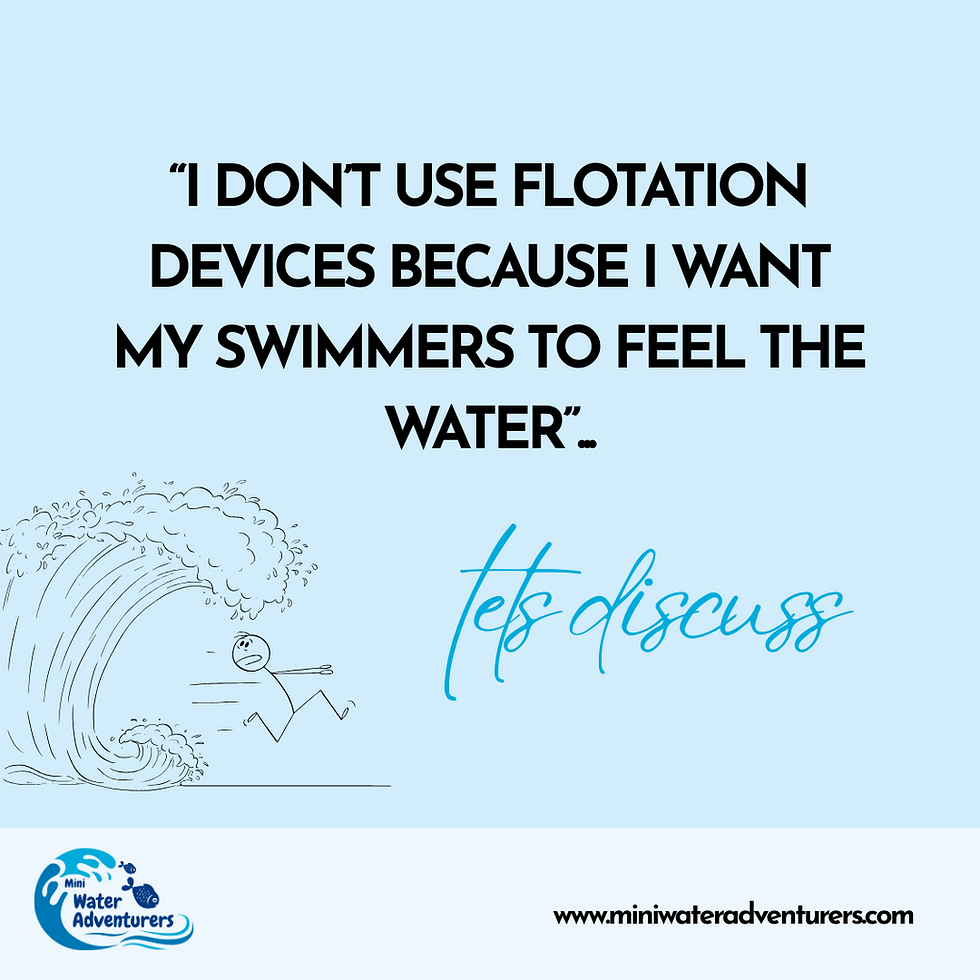Buoyancy aids vs. parental holds – are we just arguing semantics?
- Helen Hughes
- 1 day ago
- 3 min read

“I don’t use flotation devices because I want my swimmers to feel the water.”
We’ve all heard it. It’s a phrase so often repeated in swimming teaching circles that it’s become a badge of honour for some. But let’s pause and unpack what this really means.
Because here’s the truth…
If a swimmer isn’t yet confident, proficient, or buoyant enough on their own – what exactly are they feeling when we let go? Panic. Instinct. Urgency. Or worse... nothing.
Some freeze and sink. Others thrash and desperately paddle to stay up. And yet we continue to tell ourselves that this is helping them "feel" the water?
The illusion of “natural” learning
Let’s be honest. If we remove a buoyancy aid and simply replace it with our own hands, cradling a child under their arms or holding their tummy, are we truly removing support? Or are we just swapping a visible aid for a human one?
We, as teachers or parents, become the flotation device.
And yet flotation aids like the Orca Swim Trainer are unfairly vilified – often dismissed as unnecessary, even harmful, by the more traditional voices in the swimming community.
But consider this:
What’s the real difference between:
A teacher holding a child in the water
A parent’s arms under a child’s belly
A well-designed, purpose-built flotation tool that provides freedom, consistency, and correct body positioning?
Answer: Not much. Except the latter promotes independent learning, frees up hands for better teaching, and allows for repetition with reduced fatigue – on both sides.
Sinking isn’t learning
A child who can’t float or swim yet should not be left unsupported. Doing so puts them into a reactive survival state. This may look like movement – but it’s frantic, uncoordinated, and fuelled by fear.
In this state:
They are not learning effective stroke technique.
They are not mastering breath control.
They are not “feeling” the water – they’re fighting it.
And those who don't fight it? The ones who simply sink? They internalise that swimming is uncomfortable, even dangerous. That’s a lesson we never want to teach.

The power of purposeful training tools
We accept the use of aids in other sports. Tennis rackets get smaller for younger hands. Bikes have stabilisers. Footballs come in different sizes. Gymnastics uses soft foam beams and mats. So why is swimming the only sport where we insist children must master complex, full-body skills without support?
That’s not progression – that’s pressure.
Enter: The Orca Swim Trainer
The Orca Swim Trainer is not your average flotation aid. It’s a child-sized teaching tool, designed to support swimmers in the right position, boosting confidence while enabling progressive skill development.
When used correctly, it:
Encourages horizontal alignment
Allows the swimmer to move independently
Enables teachers to focus on technique
Offers support that fades over time, rather than being suddenly withdrawn
It’s not a crutch. It’s a scaffold – something that allows skill to build layer by layer until the child is genuinely ready to swim without it.
And importantly: safety skills are never practised with the Orca on. That’s intentional and essential. It’s a tool for learning, not a replacement for real-life readiness.

Research-backed? Absolutely.
Studies in developmental learning consistently show that scaffolded support leads to better retention and confidence. One 2010 study in Early Child Development and Care found that children who experienced gradual withdrawal of support had greater long-term skill acquisition and lower anxiety levels.
In aquatic education, Swim Angelfish – experts in adaptive aquatic instruction – advocate for flotation aids to support sensory integration, body awareness, and motor planning in the water.
And let’s not forget: we’re teaching a potentially life-saving skill. Using tools to help children build a strong foundation is not cheating – it’s responsible.
Time to rethink the narrative
Letting go of a child before they’re ready isn’t a test of bravery – it’s a potential barrier to learning. And simply using your hands to replace a floatation tool is a personal preference, not a pedagogical superiority.
We need to stop viewing tools like the Orca as hindrances and start recognising them as progressive, purposeful, and protective.
Because in swimming – just like in life – sometimes a little support makes all the difference.
Let’s train smarter, not tougher. Let’s give our swimmers the right tools, at the right time, with the right intention.
Feeling the water starts with feeling safe.
If you’ve found this blog helpful and you're hungry for more inspiration, guidance, and tried-and-tested ideas to transform your swimming lessons, then why not take the next step? Join Helen and a growing community of passionate swimming teachers inside the SWIM Squad membership. It’s where the magic really happens – packed with exclusive resources, expert support, and a treasure trove of fresh lesson ideas to keep your teaching fun, purposeful, and progressive. Ready to dive deeper? Come and join us today!





Comments